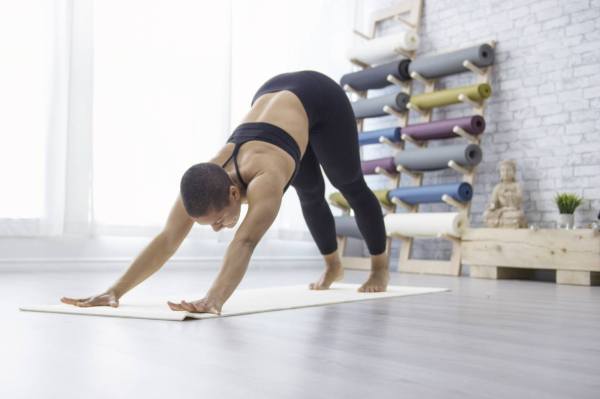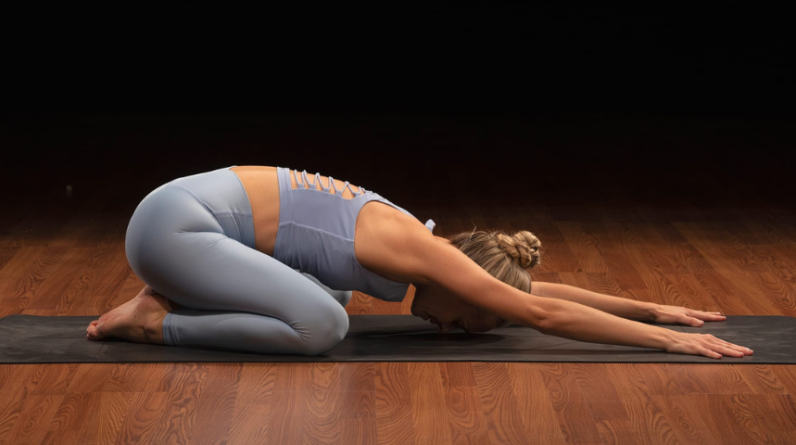
“Downward-facing dog is the most popular yoga pose for a reason,” says Lindsay Monal, RYT-500, certified yoga and sound meditation expert at YogaRenew. “It’s such a powerful and foundational posture to help stretch and strengthen the body, with the added benefit of supporting mental health too.”
Here’s everything you need to know about this yoga pose, including how to do it correctly and the benefits you’ll reap from it.
How to do downward dog perfectly every time
To get the most benefits out of your downward dog, it’s important to do it correctly. Follow these steps from Monal to try it at home.
- Start on your hands and knees in a tabletop position.
- Spread your fingers wide and press through your thumb and your index fingers.
- Engage your core muscles.
- As you inhale, tuck your toes and lift your knees up to straighten the legs.
- Lengthen your tailbone up toward the sky so your body forms an inverted “V” position.
- Bring your feet shoulder-distance apart and engage your quadriceps (the muscles at the front of your thighs).
- Allow your biceps to frame your ears.
- Press your heels toward the ground. Your heels can come lower to the mat, depending on your hamstring and calf flexibility.
- Fully extend your arms and allow your neck to be a natural extension of the spine.
- Bring your gaze to your ankles.
- Hold for several breaths before releasing back to the ground.
Benefits of downward dog that’ll convince you to add it to your yoga practice
Perhaps the most well-known benefit of practicing downward dog is its ability to improve your flexibility.
“Downward dog opens up the back of the legs, including the hamstrings, calves, and Achilles,” says Elena Cheung, E-RYT 500, a certified yoga medicine therapeutic specialist and teacher at YogaWorks.
It also stretches your back and shoulders.
“This can be especially helpful for individuals who spend a lot of time sitting or typing and who feel tension or stiffness in these areas,” Monal says.
However, the perks of practicing this pose don’t stop there. Here are five more benefits of a downward dog that go beyond flexibility.
1. It increases your strength
Downward dog pose can also be an effective strength exercise.
“With downward dog, you’re getting the added benefit of strengthening your wrists, arms, shoulders, and legs,” Monal says. “It’s really a full-body stretch, and holding this posture asks your body to engage important muscle groups in the arms and legs essential for everyday tasks and long-term mobility.”
Yoga in general showed moderately positive effects on muscle strength, balance, mobility, and lower-body flexibility in a November 2021 meta-analysis published in the International Journal of Environmental Research and Public Health.
2. It improves your mobility
On the note mobility, downward dog can help you flow through essential movements in everyday life.
“Because we’re also bearing weight on the wrists, we’re increasing bone density in the arms and cultivating the ability to get up from the ground with ease,” Monal says. “That’s an ability that’s especially important as we age.”
Downward dog also helps to target other small muscles that help you with daily tasks.
“It strengthens and stretches all the little muscles in your feet,” Cheung says. “This can be helpful for how you feel when walking and going about your day.”
3. It boosts circulation
Downward dog helps to get your blood flowing, making it a welcome pick-me-up if you’ve been sitting at your desk for hours.
“It improves circulation and stimulates blood flow, as your head is lower than your heart,” Cheung says.
Inverted postures like downward dog can promote healthy blood circulation to the brain, per a September 2019 review in the Journal of Yoga and Physiotherapy. Overall, yoga can benefit your entire circulation, from the production of blood to improved blood supply to your heart muscles.
4. It’s great for your posture
Practicing downward dog can also help you improve your posture, potentially leading to other health benefits like easier breathing.
“If you notice sitting at a computer all day is ruining your posture, downward facing dog can help with that too,” Monal says. “In the shape, we’re working to strengthen the muscles in the core and back body responsible for helping us sit upright.”
Downward dog also helps to open up the muscles that tend to get constricted as you hunch toward a screen.
“It can improve posture by opening up the chest and shoulders,” Cheung says.
5. It helps you focus
Although it will take some practice, you may start to consider downward dog to be a peaceful pause in your yoga practice.
“Once you get comfortable with it, it’s seen as a resting posture that helps to quiet the mind and leave you feeling more focused, relaxed, and alert,” Monal says.
In yoga practice, inversions like downward dog are believed to bring life force energy or “prana” up to the crown of the head.
“In doing this, a down dog helps prepare our bodies for meditation, stilling the fluctuations of the mind and preparing us to sit comfortably in a meditative seat where we can connect deeper with ourselves and all that is,” Monal says.
“It’s really a full-body stretch, and holding this posture asks your body to engage important muscle groups in the arms and legs essential for everyday tasks and long-term mobility.” —Lindsay Monal, RYT-500
Muscles worked during a downward dog
Downward-facing dog is a full-body pose with several muscles involved for strength and stability. Here are key muscles that are worked during a downward dog, according to Monal.
Upper body
- Deltoids: These shoulder muscles stabilize your arms in downward dog.
- Triceps: Located on the back of your upper arms, these help to hold you up through the extension of your arms.
- Trapezius: Found around your upper back and neck, these muscles stabilize your shoulder blades.
Core and back
- Rectus abdominis: This is the primary muscle of your abdomen that stabilizes your torso and pelvis in downward dog.
- Transverse abdominis: This deep core muscle helps to support your spine.
- Obliques: Located on the sides of your torso, these engage to help maintain stability.
- Erector spinae: These muscles of your lower back engage to help support and stabilize your spine.
Lower body
- Hamstrings: Located at the back of your thighs, these lengthen and engage to lift your hips and elongate your spine in downward dog.
- Gastrocnemius and soleus: These calf muscles engage to help stabilize your ankles and support the weight of your body.
Common downward dog mistakes
Practice makes progress when it comes to a downward dog—and all other yoga poses. Here are mistakes to avoid when you’re in this pose.
1. You keep your legs stick-straight
It’s okay for your knees to bend slightly in downward dog.
“Focusing too much on stick-straight legs can force rounding in the back and shoulders, so you look more like an upside-down ‘U’ shape,” Cheung says. “Bend your knees to elongate your spine.”
Remember: The goal of downward dog is not to have perfectly straight legs, but rather to lengthen your spine.
2. You over-lengthen your spine
On that note, it is possible to over-lengthen your spine. If you do so, you may put too much load on your lower back.
“Ideally, the spine should be long and in a relatively neutral extended position, where the pelvis and rib cage are in the right relationship to each other and the front ribs aren’t splaying out—nor the low back overarched,” Monal says.
3. You force your heels down
Your heels don’t need to be touching the ground for an effective downward dog.
“Direct your heels to the floor without being forceful, but mostly just let them lift off the floor if needed,” Cheung says. “Everyone’s body and ankle mobility is different. Overly focusing on pressing the heels down can take away from the efficacy of the pose.”
4. You glue your fingers together
Keep your fingers spread on the mat, like a big high-five.
“Think about spreading your weight evenly through the four corners of your palm, especially the space between your thumbs and pointer fingers,” Monal says. “This will reduce pressure in the wrists and make the shape more comfortable as you really work to press the ground away.”
This will also help to avoid inactive hands, which put more pressure on your wrist joints.
“If your hands keep doing the cupcake shape, try a wider stance between your hands and a slight turn out of the fingers,” Cheung says.
5. You round your spine
Bend your knees, push through your hands, and work toward a longer spine and shoulder connection to avoid a rounded spine.
“This one may just come with time if your shoulders are very tight,” Cheung says. (These stretches for tight shoulders might help, too!)
As you do so, make sure your shoulders don’t hunch forward.
“You want to think about the shoulders drawing together a bit and the chest feeling open and free, as opposed to being rounded or constricted,” Monal says.
Finally, make sure you aren’t carrying tension in your neck.
“Let your head hang heavy, instead of lifting it up,” Cheung says. “Downward dog is one of the best poses to soften tension in the neck as it dangles.”
Tips and precautions for downward dog
Always listen to your own body when practicing this posture. If you feel a sharp or shooting pain, don’t continue in the position.
“If you feel pain, consider other options like tabletop or child’s pose,” Cheung says. “Those with shoulder, ankle, hamstring, or wrist injuries should move mindfully into a down dog and pay attention to how they feel.”
Because your heart is higher than your head in this position, talk to your doctor before trying this pose if you have high blood pressure or related conditions. You should also speak to a doctor if you have certain injuries that cause pain in a downward dog. Some modifications may be possible to help you feel more comfortable.
“For students with knee issues and injuries, keep your knees bent or slightly bent,” Monal says. “It’s perfectly okay if your heels don’t touch the ground.”
Meanwhile, if you have wrist issues or injuries, focus on pressing up through your thumb and forefingers. Make sure your fingers are spread wide on the mat.
“You can also try to elevate your wrists to take pressure off them,” Monal says. “This can be done by placing a folded blanket under the wrists.”
Finally, for shoulder issues and pain, bring your hands and shoulders out a bit wider to reduce strain.
With the right form, you can reap the benefits of doing a downward dog daily—or even multiple times per day (if doing so doesn’t cause you discomfort or pain).
“It doesn’t just have to be during a yoga practice,” Cheung says. “In fact, I do down dogs in the morning, at night, or when my body feels stiff.”
Well+Good articles reference scientific, reliable, recent, robust studies to back up the information we share. You can trust us along your wellness journey.
- Shin S. Meta-Analysis of the Effect of Yoga Practice on Physical Fitness in the Elderly. Int J Environ Res Public Health. 2021 Nov 6;18(21):11663. doi: 10.3390/ijerph182111663. PMID: 34770176; PMCID: PMC8583600.
- Emina Panjeta, Mirsad Panjeta, Amela Dervišević, Jozo Ćorić. Effect of Yoga Exercise on Circulatory System. J Yoga & Physio. 2019; 8(1): 555726. DOI: 10.19080/JYP.2019.08.555726








